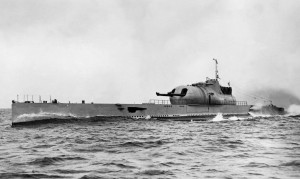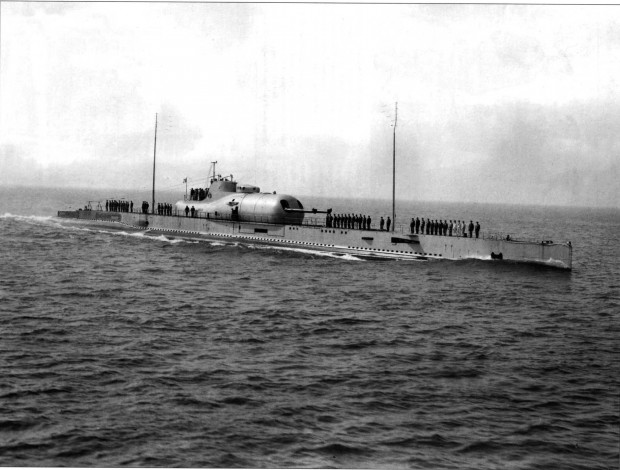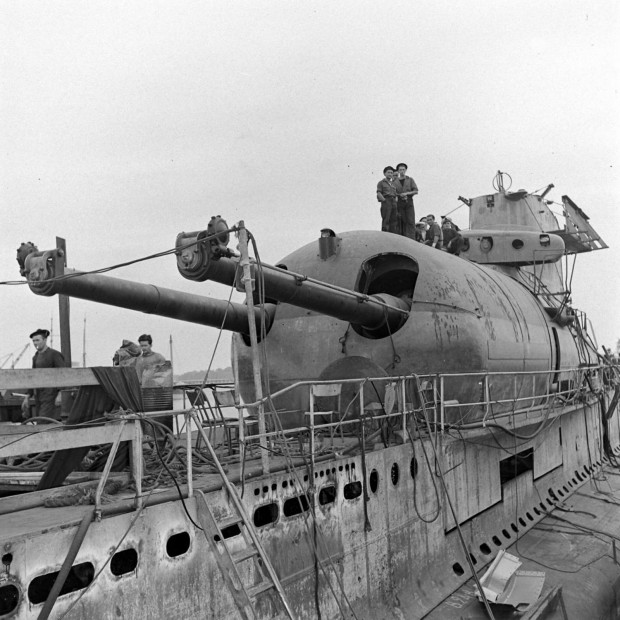Mystery Of Sub Lost After Leaving Bermuda
 The giant Free French submarine “Surcouf” — which vanished after leaving Bermuda during World War Two [1939-45] and has long been the subject of controversy and conspiracy theories — is the subject of a lengthy report in the latest issue of a Nova Scotian naval journal.
The giant Free French submarine “Surcouf” — which vanished after leaving Bermuda during World War Two [1939-45] and has long been the subject of controversy and conspiracy theories — is the subject of a lengthy report in the latest issue of a Nova Scotian naval journal.
“Bosun’s Call”, the Nova Scotia Naval Officers’ Association newsletter, recounts the story of the ill-fated French Navy “corsair submarine” — at 361-feet in length, the largest ever built up to that time.
Named after an 18th century French pirate and launched in 1929, “Surcouf was designed as an “underwater cruiser” intended to seek and engage in surface combat as well as torpedoing enemy shipping while submerged.
For reconnaissance, she carried a Besson MB.411 observation floatplane in a hangar built abaft of the conning tower; for combat, she was armed with 12 torpedo tubes and twin eight-inch guns in a pressure-tight turret forward of the conning tower.
In theory the Besson observation plane could have been used to direct fire out to the guns’ maximum range in these pre-radar days. Anti-aircraft cannon and machine guns were mounted on the top of the hangar.
Despite her impressive specifications, “Surcouf” proved to be plagued by mechanical problems: her trim was difficult to adjust during a dive, on the surface she rolled badly in rough seas, and she took over two minutes to dive to a depth of 40 feet, making her vulnerable to aircraft.
“While the German U-Boats were prowling off the Atlantic coast and the Caribbean, the Free French submarine, ‘Surcouf; patrolled the eastern seaboard from Canadian Maritimes, to New England, to Bermuda, and toward the Panama Canal Zone,” write retired American submarine captain Frederick Hallett and former US Coast Guard journalist Neal P. Cortell in “Bosun’s Call”.
“The ‘Surcouf’ became the mystery submarine of the Second World War.
” … When the Germans invaded France, ‘Surcouf’ was being refitted in Brest France, but managed to escape across the English Channel, travelling with only one functioning motor to Britain.
“The ‘Surcouf’ then travelled across the Atlantic to the US Portsmouth Naval Ship Yard in New Hampshire, Maine, to the US Navy Submarine Base in New London, Connecticut, to the Canadian Naval Dockyard in Halifax, Nova Scotia, and to the Naval Annex in Bermuda.”
While in Bermuda, “Surcouf” became the subject of widespread speculation and rumour — with Britain’s Royal Navy and US forces stationed on the island fearing the massive submarine might either go rogue and torpedo American convoys en route to Europe or attempt to defect from the Allied war cause to Vichy French territory in the West Indies or Central America. France’s puppet Vichy administration, installed by the Nazis after they conquered France in 1940, was officially neutral but aligned with Germany.
British historian James Rusbridger visited Bermuda and interviewed many local residents who were on the island during World War Two for his 1991 book on the pride of France’s navy, “Who Sank Surcouf?”
In his book Mr. Rusbridger addressed uncorroborated but persistent reports Royal Navy divers — acting on the instructions of British espionage chieftains — had secretly mined “Surcouf’s” hull while it was in Bermuda’s Royal Naval Dockyard. Supposedly the mines were timed to detonate after the submarine had left Bermuda and were intended to send the “Surcouf” and its crew to the bottom of the ocean.
The “Bosun’s Call” report continues: ”Leaving Bermuda on February 12, 1942, en route to the Panama Canal, ‘Surcouf’ was never seen again. ‘Surcouf’ was not in the best of condition according to those who worked on her at Portsmouth Naval Shipyard in Kittery, Maine, four months earlier.
“During a previous visit to Bermuda she had suffered from a large fuel leak and a seawater leak into her battery compartment, which caused a serious chlorine gas problem. And many of her crew were fairly new to submarines, having come aboard after she arrived in England in 1940.
“Part of the problem in maintaining her was lack of repair parts. She was full of French-made equipment, and France was under German control. So, an operational failure is a real possibility.”
Captain Hallett and Mr. Cortell say the official version of how she was lost, accepted by many on both sides of the Atlantic, is that “Surcouf” was sunk in a night-time collision with the American freighter SS ”Thompson Lykes” about 78 nautical miles north of the Panama Canal entrance.
“However, this scenario does not match any of the ship logs to document any operations of that sort during the factual time frame,” they said, arguing she may have in fact been depth-charged in the Caribbean by US aircraft which mistook “Surcouf” for a Nazi submarine.
“In any event, American Navy intelligence had a policy of not publicly confirming U-boat sinkings and obviously was disturbed by the demise of the Free French ‘Surcouf’ that made the news in North America and Europe [fighting alongside the Allies],” the writers concluded.
In remembrance of the submarine and its lost, 130-man crew a memorial was unveiled on September 23 1951 by former Free French leader and future French president General Charles de Gaulle on the quayside at Cherbourg, “Surcouf’s” home port.
Read More About
Comments (6)
Trackback URL | Comments RSS Feed
Articles that link to this one:
- Requiem Honoured Bermuda Sub Disaster Victim | Bernews.com | April 9, 2012
- Thriller Tries To Solve Submarine Mystery | Bernews.com | December 29, 2013
- Video: Mystery Of Sub Lost Off Bermuda In 1942 | Bernews.com | March 16, 2014




Very interesting read- hopefully the vessell will be found…or declassified “top secret’ documents will shed light on its demise. Until then a mystery indeed!
Sean Field-Lament
As a boy I remember being told about that french sub in WW2 by my father who was in the BVRC and then the Bermuda police for the 2ed half of WW2 . He told me that sub was suspected of changing sides and was indeed sinking our food boats . It was decided to take matters into their own hands and a number of USAAF planes were sent to send it to the bottom as soon as she had resupplied in Bermuda and as soon as she had enough distance so as not to be seen from Bermuda. He told me it was blown out of the water and that was , the end of the matter. A little bit of history as I remember is but it’s what I was told and I remember that story well.
White Paper about The Surcouf Conspiracy
The Most Bizarre and Occult Story Never Told about a Submarine
The Surcouf Conspiracy, within 451 pages and 75 photographs, is a penetrating analysis about the elite submarine SURCOUF, the pride of the Free French Navy, which the SS THOMPSON LYKES, an American freighter, rammed in the dead of a Caribbean night, along the fringes of the Bermuda Triangle during World War II.
SURCOUF entered The Guinness Book of Records as the world’s worst submarine disaster when she sank, faster than she could crash dive, with 130 aboard, including three of the Royal Navy. No submarine has rivaled her unenviable record, although the USS THRESHER in April 1963 tried with 129 losses.
According to the renowned British naval journalist Hector C. Bywater, who, in his 1925 book The Great Pacific War foretold the Imperial Japanese Navy’s surprise attack upon Pearl Harbor, SURCOUF, with her twin 8-inch guns and a reconnaissance seaplane, was destined to die by collision before she came into existence in 1929 as the largest, most powerful, undersea monster in naval warfare.
Dating back to 1805, when Robert Surcouf, the French corsair of St Malo ruthlessly ravaged the British East Indiaman KENT in the in the Indian Ocean, the name Surcouf was despicably detested by the Crown of England and the Royal Navy, and a huge reward was offered for his death. The submarine SURCOUF, even though she served under the command of Flag Officer, Submarines, Royal Navy, during World War II, gave little reason for passionate amour when her gunnery and medical officers, as an act honoring the traditions of the French Navy, killed three of the Royal Navy along her decks during Operation GRASP on July 3, 1940. Her proud French name was further discredited by vicious rumors that she was a traitor submarine that refueled and supplied German U-boats.
Yet, Surcouf gained imperishable fame when she participated in the liberation of the Vichy held St. Pierre and Miquelon Islands on December 1941, which Ira Wolfert, in his book An Act of Love, wrote that the liberation of the St. Pierre and Miquelon Islands was the best Christmas present given to a people desiring to be free. It was what the war was all about, and one of the first occurrences during which people were liberated from the political oppression of Vichy France. Yet, for her role in the St. Pierre and Miquelon Affair, diplomats considered it an act of unauthorized piracy that caused President Roosevelt to threaten to deploy the battleship USS ARKANSAS to forcibly remove SURCOUF from the North Atlantic.
Every legend has an untold story and the one about the dishonor and forces of evil, which relentlessly plagued SURCOUF, the deadliest threat to England’s supremacy at sea, is finally revealed. Evil came in a chain of supernatural and real happenings that afflicted SURCOUF, even before she was conceived, to die as the world’s worst submarine disaster on February 18, 1942.
Two versions of SURCOUF’s life and death are united: the occult and the real. They were in search of one another as both were integral to the occurrence of the SURCOUF-SS THOMPSON LYKES Collision. So many unreal happenings preceded that unholy event that they ultimately fused with actuality.
Something was drastically amiss onboard SURCOUF else wise why would the British Naval Liaison Officer remark to a Royal Canadian naval officer that he was shaking hands with a dead man if he remained onto her when she departed Halifax for Bermuda during January 1942.
Two explosions rocked SURCOUF’s hulk as she sank, leading some French to believe that limpet mines were secured to her hull while she lay at Ireland Dockyard, Bermuda, before her departure for the South Pacific. They adamantly suspected a Garbage Squad attached them under the direction of a double agent in the office of Intrepid, England’s spymaster in New York, with intent to block the Gatun Locks of the Panama Canal while SURCOUF was in transit.
The never told circumstances behind SURCOUF’s pitiful loss have remained, until now, one the most bizarre and occult sea sagas to emerge from World War II. Integrated throughout SURCOUF’s story line is documented commentary involving highest level wartime American, British, Free French and Vichy French diplomatic, political, and naval personages; like Churchill, de Gaulle, Roosevelt, Hull, Eden, Horton, and Darlan.
Also, interwoven into SURCOUF’s dramatic saga are the weird roles played by American, Bermudian, British, and French women long before SURCOUF’s existence and during her tumultuous life and her compelling afterlife. Not since Lady Hamilton, Lord Nelson’s mistress, have women appeared as forcefully in naval history as throughout SURCOUF’s embroiled life and after her frightful death.
The author offers a $1,000,000 in gold if it can be proved officially that SURCOUF was a traitor submarine or that she was not sunk by the SS THOMPSON LYKES.
The Surcouf Conspiracy is available on Amazon as a hard back, paper cover, or on Kindle.